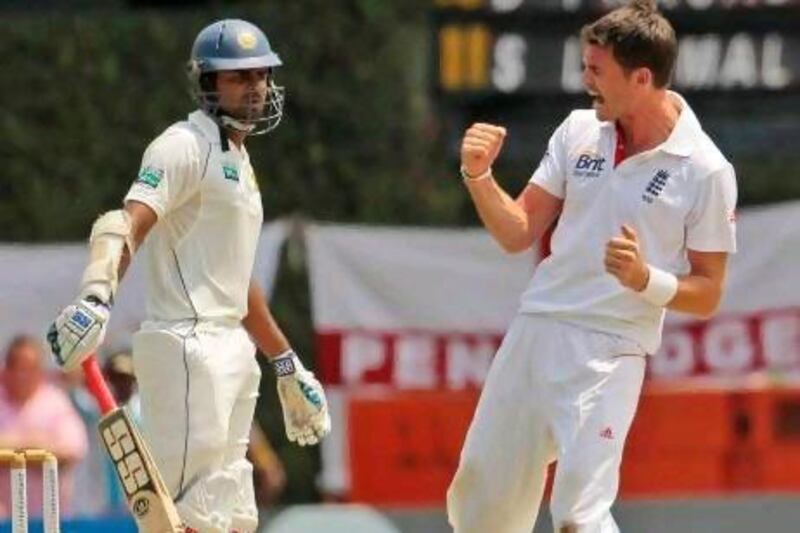The best way to understand the James Anderson from this winter and the James Anderson of his early years is through The Beatles.
Where The Beatles once sang simple, single level, addictive ditties like I Want To Hold Your Hand, four years later they were constructing the vast, sprawling soundscapes of I Am The Walrus which could be examined at multiple levels but never grasped entirely.
This was not just a sonic growth. It was an evolution of the mind, an opening of it to life beyond love and Liverpool, beyond even London and New York and this existence. Entire perspectives and sensibilities had shifted.
Somewhere in them was still the capacity for that short, sweet burst of pop, but this was so much more, what is the word, substantial?
This is what has happened with Anderson since that first, exhilarating flush the world came across in Cape Town in February 2003, against Pakistan at the World Cup. At that time he felt a passing presence, his career defined by a series of "can'ts".
He cannot bowl with that action, head down looking at feet at delivery. He cannot keep getting such conditions in which to swing the ball. He cannot keep looking for and finding those deliveries which did for Inzamam-ul-Haq and Yousuf Youhana (as an aside, those two new ball, outswinging yorkers were a deliciously orthodox payback to years of England being canoodled by the unorthodox old-ball, reverse inswinging yorkers of Wasim Akram and Waqar Younis).
He cannot be serious about the blonde highlights. He cannot.
For a long while, he could not.
Then, during the summer of 2007 but mostly the following summer, he could and he did. And to see him bowl now is to see a multicoloured, 3D version of his earlier self, as if the 2003 Anderson is being watched through a kaleidoscope.
He still has in him, just like the Beatles did, that bit of his old self (including the action he was born with but which he had briefly abandoned).
Every now and again he will produce the magic ball, like the one that did for Imran Farhat at Trent Bridge on his 28th birthday in 2010; from around the wicket, it curved in to middle and leg with the force and intent of an F1 car taking a wide corner before pitching and actually breaking like a leg-break to take off.
It deserved a better victim.
In his younger days, he searched for that ball every time he ran in, only to produce it once an innings and that too without knowing when it would come.
When he runs in now, he knows, the batsman knows and we know that it can come but will only do so when Anderson wills it.
Now he has so much else to show off. Along with Zaheer Khan and Dale Steyn, he is now a bowler whose spells are compulsory viewing for their craft, range of skills and modes of attack. In England's Ashes-obsessed cycle, Anderson proved himself a bowler for all conditions in Australia in 2010/11, where he bowled long, dry spells to deny batsmen runs.
It was a test, because the ball does not swing as much in Australia but it is not as if fast bowlers struggle in that country.
No, the real sign of how much Anderson has evolved was this winter just gone in the UAE and Sri Lanka. It is not that fast bowlers do not, or cannot, prosper here. Eighteen wickets in five Tests, four of which were lost, should not mask the fact that Anderson was the best fast bowler through the two series.
Here was an athlete in a beautiful, rare space in his career, at its absolute peak, in control, secure in his mind, grooved technically, physically fit: just perfectly and delicately synched.
In some hands, the ball does not rest so comfortably (with Ajit Agarkar and Lasith Malinga it looks far too big) but with Anderson it looks like the forefinger and middle finger were created and shaped specifically for a ball to be nestled in.
The new ball was treated with the same love and care he has always lavished upon it. Only now, he is not quite the lost lover when the shine goes.
Now he has cutters and he can extract more seam movement out of an oldish ball than most (a handy trait he picked up from Mohammad Asif). He is also a mean reverse swinger.
The most significant discovery has been to find his best lengths. Because he could always swing it, locating the optimum length was a problem: too full and be driven, shorter and be seen out.
But in 2008, he found the length that worked for him. It is not that there are standardised lengths in bowling that all bowlers can bowl to and succeed with.
Each bowler, given his height, his action, his arm at release, finds his own natural, correct length and it was this that changed Anderson.
And so watching him was a reminder of others who have had to adjust to succeed in this region, like Glenn McGrath, Darren Gough, Malcolm Marshall and Richard Hadlee and also those who knew how to bowl here because this was home, like Wasim Akram and Chaminda Vaas.
The luck is in for us, because this summer when England play host to South Africa, Anderson comes face to face with the only other fast bowler of this recent age who has flourished across the world: Steyn.
Follow us
[ @SprtNationalUAE ]





